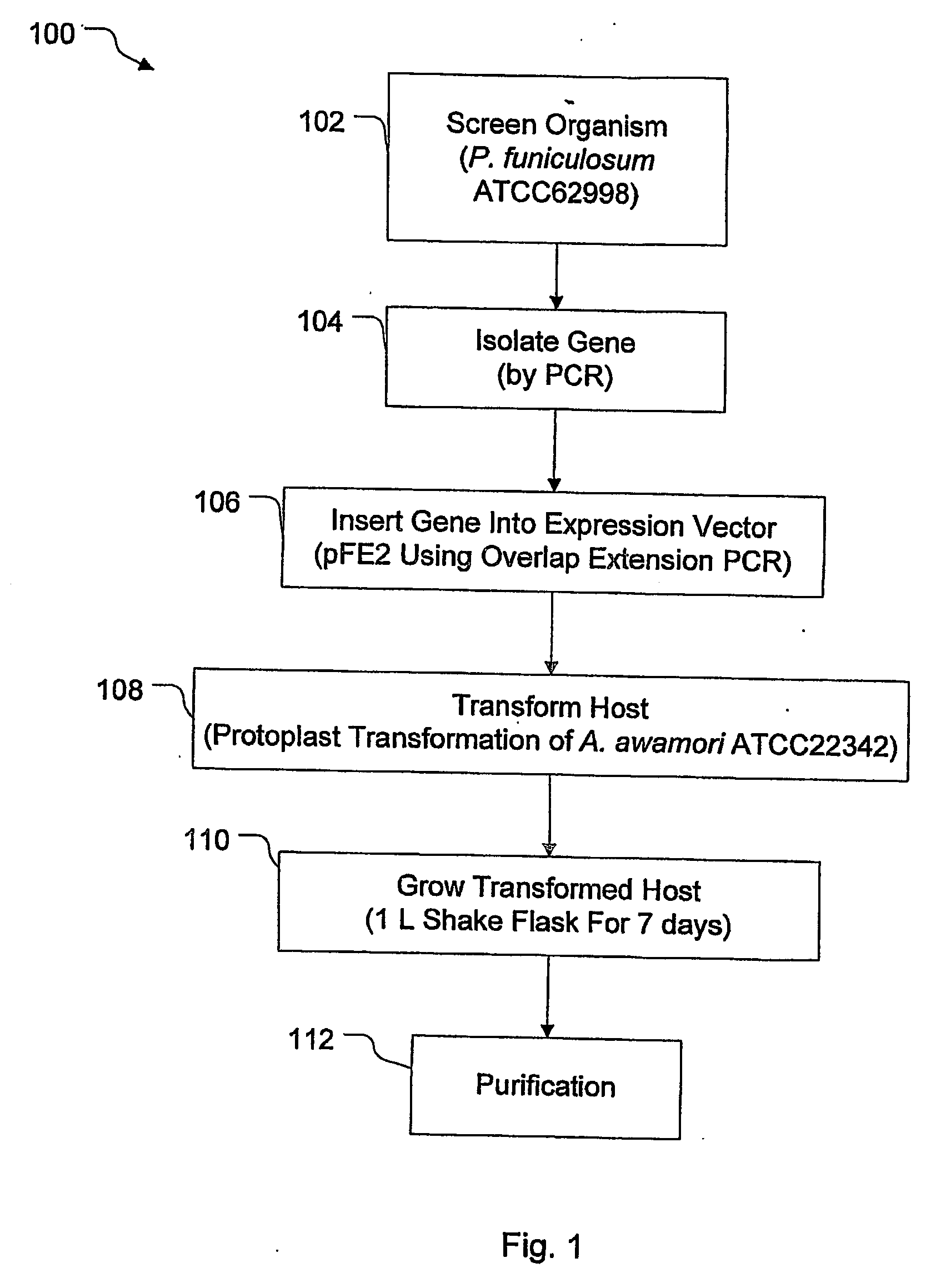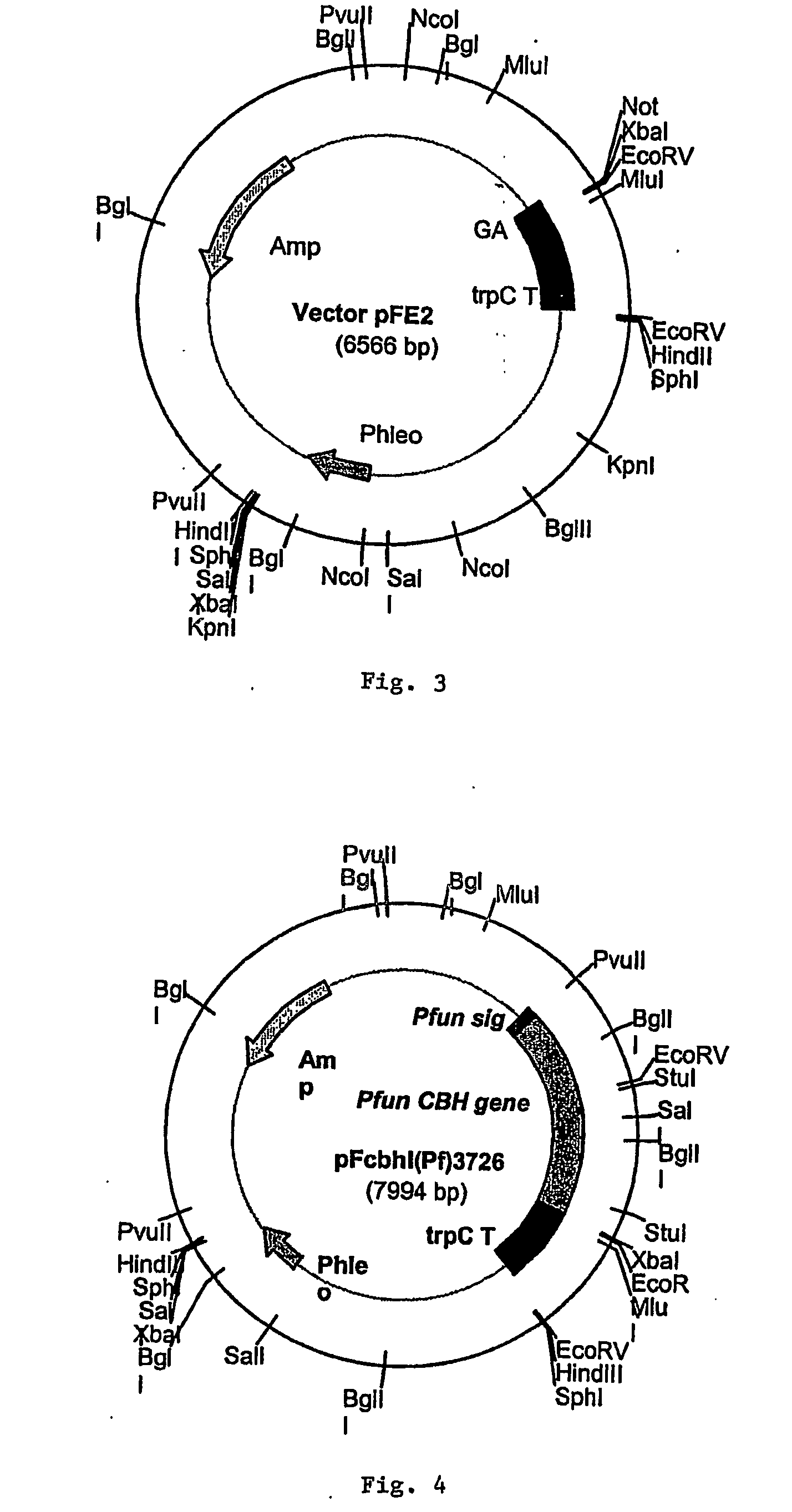Superactive cellulase formulation using cellobiohydrolase-1 from penicillium funiculosum
a cellulase and cellobiohydrolase technology, applied in the field of cellulases, can solve the problems of significant cost factor, inability to provide hydrolyzing enzymes, and inability to meet the specific performance of cel7a, and achieve superior performance and facilitate the effect of increasing cel7a specific performan
- Summary
- Abstract
- Description
- Claims
- Application Information
AI Technical Summary
Benefits of technology
Problems solved by technology
Method used
Image
Examples
example 1
ISOLATING A Cel7A GENE FROM P. funiculosum
[0038] The coding sequence for the cel7A gene from P. funiculosum (ATCC 62998) (SEQ ID NO. 7 of FIG. 2) was inserted and expressed in the fungal host Aspergillus awamori (ATCC 22342) using the fungal expression vector pEE2. As shown in FIG. 3, the pFE2 vector is an E. coli—Aspergillus shuttle vector, and contains elements required for maintenance in both hosts. The pFE2 vector directs the expression and secretion of the protein of interest as a fusion protein with a portion of the glucoamylase (GA) gene fused to the cel7A gene. The vector contains the Streptoalloteichus hindustanus phleomycin resistance gene (Phleo) under the control of the A. niger β-tubulin promoter, for positive selection of Aspergillus transformants. The vector also contains a β-lactamase gene for positive selection using ampicillin in E. coli, and the A. niger trpC terminator (trpC T). In this case, the rCel7 protein from P. funiculosum was expressed with its own secre...
example 2
TRANSFORMING A. awamori
[0057] Aspergillus awamori (ATCC22342) spore stocks were stored at −70° C. in 20% glycerol, 10% lactose. After thawing, 200 μL of spores were inoculated into 50 mL CM-glucose broth (5 g·L−1 Yeast Extract; 5 g·L−1: Tryptone; 10 g·L−1 Glucose; 20X Clutterbuck's Salts (120.0 g·L−Na2NO3; 10.4 g·L−1 KCl; 10.4 g·L−1 MgSO4.7H2O; 30.4 g·L−1 KH2PO4) 50 mL·L−1) at pH 7.5 in each of eight-baffled 250 mL Erlenmeyer flask. The cultures were grown at 28° C., 225 rpm for 48 h.
[0058] The mycelial balls were removed by filtration through sterile Miracloth (Calbiochem, San Diego, Calif.) and washed thoroughly with sterile KCM (0.7M KCl, 10 mM MOPS, pH 5.8) to remove ungerminated spores. Approximately 10 g wet weight of washed mycelia were transferred to 50 mL KCM+250 mg Lysing Enzyme from Trichoderma harzianum (Sigma-Aldrich, St. Louis, Mo.) in a 250 mL baffled Erlenmeyer flask. The digestion mixture was incubated overnight at 30° C., 80 rpm.
[0059] Following digestion, the m...
example 3
Culturing A. awamori
[0061] For enzyme production, spores were inoculated into 50 mL CM basal fermentation medium (5.0 μl Enzymatic Casein Hydrolysate; 5.0 g·L−1 NH4CL; 10.0 g·L−1 Yeast Extract; 10.0 g·L−1 Tryptone; 2.0 g·L−1 MgSO4.7H2O; 50.0 μL−1Soluble Starch; 50 mM Bis-Tris-Propane, pH 7.0), and grown at 32° C., 225 rpm in 250 mL baffled flasks. The cultures were transferred to 1.0 L of basal fermentation medium in 2800 mL Fernbach flasks and grown under similar conditions. The flasks were harvested by filtration through Miracloth after 7-10 days of growth.
PUM
| Property | Measurement | Unit |
|---|---|---|
| temperature | aaaaa | aaaaa |
| pH | aaaaa | aaaaa |
| pH | aaaaa | aaaaa |
Abstract
Description
Claims
Application Information
 Login to View More
Login to View More - R&D
- Intellectual Property
- Life Sciences
- Materials
- Tech Scout
- Unparalleled Data Quality
- Higher Quality Content
- 60% Fewer Hallucinations
Browse by: Latest US Patents, China's latest patents, Technical Efficacy Thesaurus, Application Domain, Technology Topic, Popular Technical Reports.
© 2025 PatSnap. All rights reserved.Legal|Privacy policy|Modern Slavery Act Transparency Statement|Sitemap|About US| Contact US: help@patsnap.com



